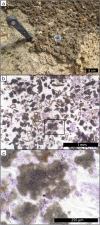The microbial carbonate factory of Hamelin Pool, Shark Bay, Western Australia
- PMID: 35902605
- PMCID: PMC9334266
- DOI: 10.1038/s41598-022-16651-z
The microbial carbonate factory of Hamelin Pool, Shark Bay, Western Australia
Abstract
Microbialites and peloids are commonly associated throughout the geologic record. Proterozoic carbonate megafacies are composed predominantly of micritic and peloidal limestones often interbedded with stromatolitic textures. The association is also common throughout carbonate ramps and platforms during the Phanerozoic. Recent investigations reveal that Hamelin Pool, located in Shark Bay, Western Australia, is a microbial carbonate factory that provides a modern analog for the microbialite-micritic sediment facies associations that are so prevalent in the geologic record. Hamelin Pool contains the largest known living marine stromatolite system in the world. Although best known for the constructive microbial processes that lead to formation of these stromatolites, our comprehensive mapping has revealed that erosion and degradation of weakly lithified microbial mats in Hamelin Pool leads to the extensive production and accumulation of sand-sized micritic grains. Over 40 km2 of upper intertidal shoreline in the pool contain unlithified to weakly lithified microbial pustular sheet mats, which erode to release irregular peloidal grains. In addition, over 20 km2 of gelatinous microbial mats, with thin brittle layers of micrite, colonize subtidal pavements. When these gelatinous mats erode, the micritic layers break down to form platey, micritic intraclasts with irregular boundaries. Together, the irregular micritic grains from pustular sheet mats and gelatinous pavement mats make up nearly 26% of the total sediment in the pool, plausibly producing ~ 24,000 metric tons of microbial sediment per year. As such, Hamelin Pool can be seen as a microbial carbonate factory, with construction by lithifying microbial mats forming microbialites, and erosion and degradation of weakly lithified microbial mats resulting in extensive production of sand-sized micritic sediments. Insight from these modern examples may have direct applicability for recognition of sedimentary deposits of microbial origin in the geologic record.
© 2022. The Author(s).
Conflict of interest statement
The authors declare no competing interests.
Figures








Similar articles
-
Comparative Metagenomics Provides Insight Into the Ecosystem Functioning of the Shark Bay Stromatolites, Western Australia.Front Microbiol. 2018 Jun 25;9:1359. doi: 10.3389/fmicb.2018.01359. eCollection 2018. Front Microbiol. 2018. PMID: 29988640 Free PMC article.
-
New multi-scale perspectives on the stromatolites of Shark Bay, Western Australia.Sci Rep. 2016 Feb 3;6:20557. doi: 10.1038/srep20557. Sci Rep. 2016. PMID: 26838605 Free PMC article.
-
Active eukaryotes in microbialites from Highborne Cay, Bahamas, and Hamelin Pool (Shark Bay), Australia.ISME J. 2014 Feb;8(2):418-29. doi: 10.1038/ismej.2013.130. Epub 2013 Aug 8. ISME J. 2014. PMID: 23924782 Free PMC article.
-
Stromatolites in Precambrian carbonates: evolutionary mileposts or environmental dipsticks?Annu Rev Earth Planet Sci. 1999;27:313-58. doi: 10.1146/annurev.earth.27.1.313. Annu Rev Earth Planet Sci. 1999. PMID: 11543060 Review.
-
A review of microbial-environmental interactions recorded in Proterozoic carbonate-hosted chert.Geobiology. 2023 Jan;21(1):3-27. doi: 10.1111/gbi.12527. Epub 2022 Oct 21. Geobiology. 2023. PMID: 36268586 Free PMC article. Review.
Cited by
-
Environmental metabolomics characterization of modern stromatolites and annotation of ibhayipeptolides.PLoS One. 2024 May 23;19(5):e0303273. doi: 10.1371/journal.pone.0303273. eCollection 2024. PLoS One. 2024. PMID: 38781236 Free PMC article.
-
Microbes as marine habitat formers and ecosystem engineers.Nat Ecol Evol. 2024 Aug;8(8):1407-1419. doi: 10.1038/s41559-024-02407-7. Epub 2024 Jun 6. Nat Ecol Evol. 2024. PMID: 38844822 Review.
References
-
- Jahnert RJ, Collins LB. Characteristics, distribution and morphogenesis of subtidal microbial systems in Shark Bay, Australia. Mar. Geol. 2012;303–306:115–136. doi: 10.1016/j.margeo.2012.02.009. - DOI
-
- Suosaari EP, et al. Stromatolite provinces of Hamelin pool: Physiographic controls on stromatolites and associated lithofacies. J. Sediment. Res. 2019;89:207–226. doi: 10.2110/jsr.2019.8. - DOI
-
- Burne RV, Moore LS. Microbialites: Organosedimentary deposits of benthic microbial communities. Palaios. 1987;2:241–254. doi: 10.2307/3514674. - DOI
-
- Walter MR, Buick R, Dunlop JSR. Stromatolites 3400–3500 Myr old from the North Pole area, Western Australia. Nature. 1980;284:443–445. doi: 10.1038/284443a0. - DOI
-
- Lowe DR. Stromatolites 3,400-Myr old from the Archean of Western Australia. Nature. 1980;284:441–443. doi: 10.1038/284441a0. - DOI
Publication types
MeSH terms
Substances
LinkOut - more resources
Full Text Sources
Research Materials

